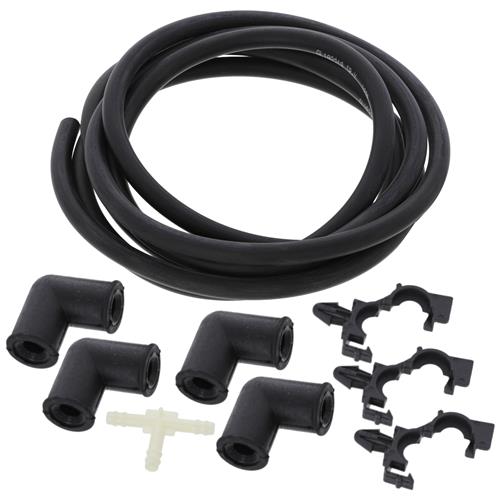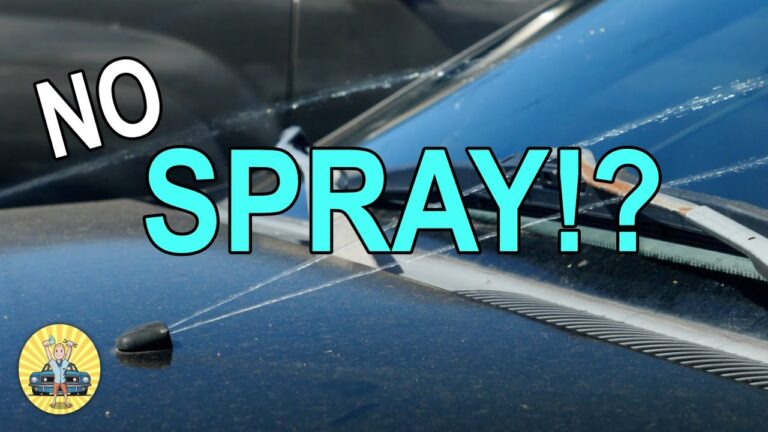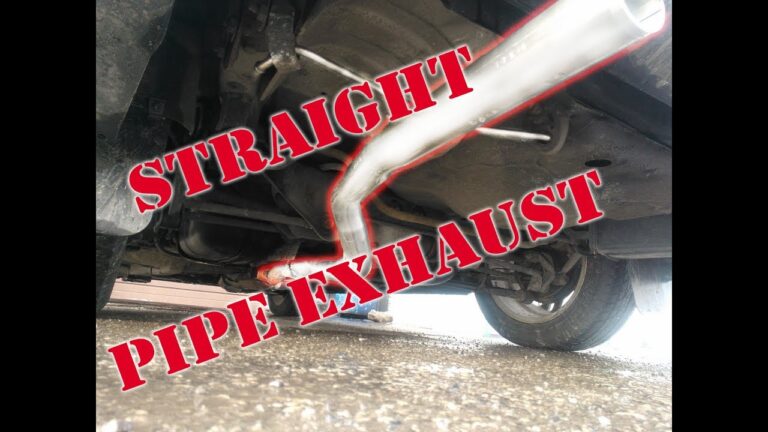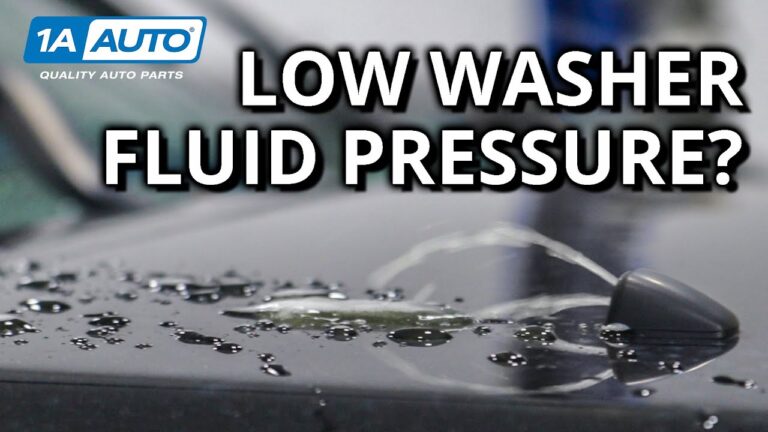Revive Your Wipers with Windshield Washer Fluid Tube Repair
To repair a windshield washer fluid tube, locate the damaged area, replace the faulty section, and secure the connections. It can be frustrating when your windshield washer fluid stops working due to a damaged tube.
The tube can become cracked or broken over time due to weather conditions or general wear and tear. Repairing a windshield washer fluid tube is a fairly simple task that can be accomplished with the right tools and a bit of patience.
In this article, we will discuss the steps involved in repairing a windshield washer fluid tube, including how to locate the damaged area, replace the faulty section, and secure the connections to ensure proper functionality.
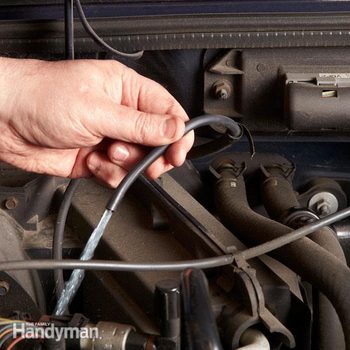
Credit: www.familyhandyman.com
Signs Of Tube Clogging
Windshield washer fluid is essential for keeping your windshield clear while driving. However, over time, your windshield fluid tubes may become clogged, making it difficult for the fluid to reach the windshield. Therefore, it is essential to know the signs of clogged washer fluid tubes to avoid further damage to the wiper system.
Weak Wiper Spray Or No Spray At All
The most apparent sign of a clogged tube is when your wiper spray is weak, or there is no spray at all. This occurs because no fluid is coming out due to a blockage in the tubes. As a result, it becomes difficult to clean your windshield.
Visual Examples Of Clogged Tubes
If you suspect your windshield washer fluid tubes are clogged, there are a few ways to diagnose the problem. Here are some visual examples:
- Look for visible damage to the tubes, such as cracks or breaks
- Disconnect the tubes from the washer nozzles and try to blow air through them
- Look for any leaks in the tubes
The Need For A Quick Fix
If you notice any of the symptoms listed above, it is essential to fix the problem promptly. The longer you ignore the clog, the more damage it can cause to the wiper system.
Additionally, a quick fix will save you money in the long run. Instead of paying for a costly repair or replacement, you can fix the problem early, prolonging the life of the wiper system.
Remember that preventive measures are better than a cure. Therefore, always keep an eye on your windshield washer fluid system to avoid any inconvenience while driving.
Tools & Materials Needed
Required Tools And Materials For Windshield Washer Fluid Tube Repair
To fix the windshield washer fluid tube, you need specific tools and materials. It’s essential to have everything you need before starting, so you don’t run into any unexpected problems. Here are the required tools and materials needed for the repair:
Pliers
Pliers are a versatile tool that you can use for various tasks. For this repair task, you need these for removing the old windshield washer fluid tube from the car. Pliers are also handy for bending and adjusting the new tube to fit your car’s shape.
Cleaning Solution
Cleaning solution helps you clean the windshield wiper reservoir and tube, making it simple and straightforward to install the new tube tightly. After disconnecting the old tube from the reservoir, it’s essential to use the cleaning solution on the connection points to ensure a tight seal.
Replacement Tubes
You need a windshield washer fluid tube that fits your car’s make and model to replace the old tube. Depending on your car’s shape, you may need to adjust the new tube’s shape slightly. Ensure you have the correct length of tubing for an easy installation.
Screwdriver
A screwdriver can help you remove screws holding the reservoir in place. You may need one or two sizes of screwdrivers based on the screw’s size.
Hose Connector
A hose connector can be helpful when you need to connect or disconnect the tube from the reservoir. It makes it easier to troubleshoot and replace the tubing when required.
Wire Brush
A wire brush is an excellent tool for cleaning the connector port. Use a wire brush before installing the new tube to remove any debris and ensure a secure fit.
To sum up, it’s essential to have all the necessary tools and materials when replacing a windshield washer fluid tube, ensuring a seamless job. With these tools, you can replace the tube effortlessly and have clear visibility in no time.
Step-By-Step Repair Process
Identifying The Location Of The Clogged Tube
If you’re having an issue with your windshield washer not spraying any fluid, it could be due to a clogged tube. The first step is to identify the location of the clogged tube. Here’s what you need to do:
- Look for the rubber tubing that runs from the washer fluid reservoir to the nozzles on your vehicle’s windshield.
- Check for any visible damages or leakage along the tube.
- Use a pin to poke through the nozzle opening to check if the tube is clogged.
- Test the windshield washer system to confirm the tube is clogged.
Removing The Old Tube
Once you’ve located the clogged tube, you’ll need to remove the old one. Follow these steps:
- Detach the old tube from the nozzles and washer fluid reservoir.
- Gently pull the tubing away from the vehicle’s body. You can use pliers to avoid damaging the tubing while pulling it out.
- Inspect the old tubing for damages or cracks. If you find any, it’s best to replace the whole tubing.
Cleaning The Area And The New Tube
Before installing the new tube, you need to clean the nozzles and the area surrounding them. Here are the steps to clean the area and install the new tube:
- Use a clean cloth to wipe the nozzles and the surrounding area to remove any debris or dirt.
- Rinse the area around the nozzles with water.
- Attach the nozzle to the new tube.
- If the nozzle is too tight for the new tube, warm the nozzle gently using a hair dryer. It will soften the rubber nozzle to allow the tube to slide in quickly.
Installing The New Tube
Once you’ve cleaned the area and attached the nozzle to the new tube, you’re ready to install the tube. Here are the steps:
- Using your pliers, insert the new tube into the same hole from where you removed the old one.
- Push the tubing through the opening until it reaches the other end.
- Guide the tubing through the same path as the old tubing, making sure it is snugly in place.
- Reattach the nozzles and the washer fluid reservoir.
Testing The New Wiper System
Finally, test the new wiper system to make sure everything is working fine. Follow these steps:
- Turn on your vehicle’s ignition and switch on the wiper system.
- Test the windshield washer system by pressing the lever associated with it.
- Look for any leaks or damages on the new tubing and around the nozzles.
- Check if the new tubing is securely attached to the nozzles and washer fluid reservoir.
Remember, if you have any difficulties repairing the windshield washer fluid tube, consult a professional mechanic.
Other Wiper Maintenance Tips
Suggest Additional Tips For Maintaining Windshield Wipers, Such As Cleaning Wiper Blades And Replacing Them Regularly
Regular maintenance of the wiper system is vital to keeping it running smoothly and preventing unexpected failure. Here are some additional tips to maintain your windshield wipers effectively:
- Regularly clean the wiper blades with a soft cloth and mild detergent to remove any debris and dirt build-up that may cause streaking or smearing.
- Keep the windshield clean to prevent excessive wear and tear on the wiper blades.
- When not in use, retract the wiper blades so that they do not get stuck to the windshield in cold weather.
- Inspect the blades for any signs of damage such as cracks, tears, or missing pieces and replace them immediately to avoid further damage to the windshield and wiper system.
- Do not use the wipers on a dry windshield as this can cause significant damage to the blades and wiper motor.
Emphasize The Role Of Washer Fluid In Keeping The Wiper System Functioning Properly
Washer fluid is an essential component of the wiper system that must not be overlooked. It is responsible for maintaining a clear view of the road during inclement weather by removing dirt, grime, and other debris from the windshield. Most importantly, it lubricates the wiper mechanism to reduce friction and prevent wear and tear on the wiper blades.
Using water or other low-quality washer fluids can damage the system as they may contain chemicals that degrade the blades or clog the washer system. Always use a high-quality washer fluid that is recommended by the vehicle manufacturer for uninterrupted wiper performance.
Mention How This Repair Can Prevent Future Wiper Failure
Windshield washer fluid tube repair is a crucial preventative maintenance measure that can save you money and avoid future wiper failure. A damaged or clogged washer fluid tube can allow dirt and other contaminants to enter the wiper system, causing mechanical damage to the wiper blades and motor.
Repairing the washer fluid tube can ensure that the wiper system remains free from unwanted debris and contamination. This will extend the life of the wiper blades and motor while maintaining optimal wiper performance. Investing in this repair now can prevent costly repairs and ensure your safety on the road.
Frequently Asked Questions Of Windshield Washer Fluid Tube Repair
Can I Drive My Car With A Broken Windshield Washer Fluid Tube?
It’s not recommended to drive with a broken windshield washer fluid tube as it can lead to reduced visibility, particularly in poor weather conditions.
How Often Should I Replace My Windshield Washer Fluid Tube?
Windshield washer fluid tubes typically last for several years. However, they may eventually crack or break due to wear and tear. It’s best to inspect them as part of regular maintenance and replace them if necessary.
How Can I Tell If My Windshield Washer Fluid Tube Is Damaged?
If you notice that your windshield washer fluid is not spraying properly or if you see fluid leaking from under your vehicle, it may be indicative of a damaged windshield washer fluid tube.
Is It Easy To Repair A Broken Windshield Washer Fluid Tube?
Repairing a windshield washer fluid tube is a relatively easy task that can be completed with basic tools. You may need to remove some parts of the car in order to access and replace the damaged tube.
Can I Use Any Type Of Tubing To Repair My Windshield Washer Fluid Tube?
It’s important to use tubing that is specifically designed for automotive use when repairing a windshield washer fluid tube. This ensures that the tube will be durable and safe, and won’t degrade due to exposure to windshield washer fluid or other contaminants.
Conclusion
After reading this guide, we can conclude that repairing the windshield washer fluid tube can be a daunting task, but with the right tools and some clear instructions, it is definitely doable. It’s important to always prioritize safety and carefully assess the situation before starting the repair process.
We discussed the different reasons why the tube might malfunction and how to identify the problem area. We also learned the step-by-step process of repairing the tube and some important tips to keep in mind. With these details in mind, repairing a faulty windshield washer fluid tube can be a straightforward task and can save you a trip to the mechanic.
Don’t forget to test the tube after the repair and make sure it’s working smoothly. Happy repairing!

